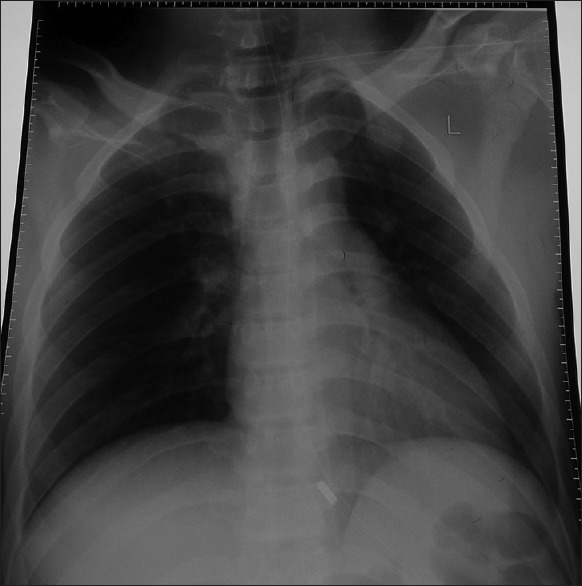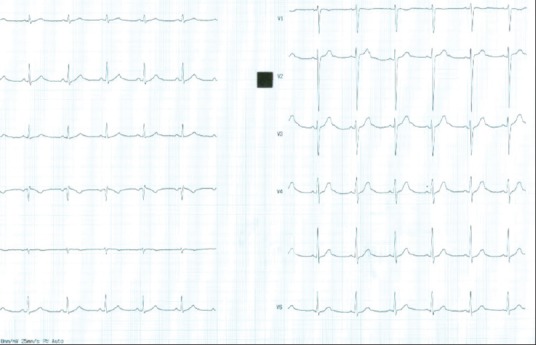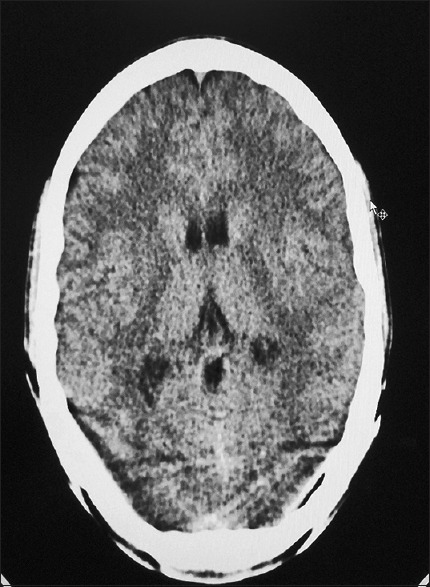Abstract
Menthol is a monocyclic terpene alcohol, which is present naturally in peppermint and can be synthesized artificially as well. Generally, it is considered as very safe and has wide usage in medicine and food. There are case reports of toxicity due to excessive consumption of menthol, but a fatal intoxication has never been reported in the medical literature. We present a case of fatal menthol intoxication in a worker, who accidently got exposed when he was working in a peppermint factory. Emergency physicians must keep in mind this extremely rare manifestation of menthol poisoning. All necessary precaution should be taken to reduce its intake or exposure, as it has no specific antidote. Early recognition and supportive treatment of this poisoning is the key for a successful outcome.
Keywords: Hematuria, menthol, peppermint, renal dysfunction, seizure
INTRODUCTION
Menthol is a monocyclic terpene alcohol having 3 asymmetric carbon atoms in the cyclo-hexane ring. Naturally, it is present in peppermint but can also be obtained synthetically. It is widely used as cooking oils, candies, mouth fresheners, cigarette, and desserts. It has also been effectively used as herbal and alternative medicine in common cold, flu, and as a digestive aid. It has a cooling, analgesic, and muscle-relaxing effect through transient receptor potential cation channel subfamily M member 8, kappa, and voltage-gated sodium channel receptors, respectively.[1] Menthol is generally considered safe and its toxic effect has rarely been reported in the literature. We here report for the 1st time a case of fatal menthol toxicity after acute exposure.
CASE REPORT
A twenty-one-year-old farmer living in a village of Uttar Pradesh, India, was brought to our emergency department in unconscious state. The history suggested that 4 days ago, he was asked to clean a tank in a peppermint factory. He got down inside the tank and soon after the inhalation of toxic fumes, he was found in unconscious state. It took an hour to bring him out from the tank. He remained unconscious and then developed recurrent convulsions and intermittent hematuria. The recurrent seizure activity was controlled with intravenous midazolam followed by intravenous levetiracetam. Supportive treatment such as nasogastric lavage and intravenous fluids were also given. The patient was then referred to our Tertiary Care Center, where we received the patient in the emergency department with stable vitals, pulse 90/min, blood pressure 130/70 mm of Hg, respiratory rate 16/min, and Glasgow coma scale (GCS) of E3V2M3. On the further history and clinical examination, there was no upper or lower limb weakness, or myoclonic jerks. Pupils were normal in size and were reactive to light, and there was no neck rigidity. The patient had an increased muscle tone in all 4 limbs, and the deep tendon reflexes were exaggerated. There was no history of substance abuse, smoking, alcohol intake, and medications. The patient's past medical history was also noncontributory. His blood results showed hemoglobin 13.1 g/L, total leukocyte count 10,400/µL, platelet 180,000/µL, blood urea 44 mg/dL, serum creatinine 2.8 mg/dL, Na 146 mEq/L, K 3.9 mEq/L, blood sugar 119 mg/dL, serum glutamic oxaloacetic transaminase 148 U/L, serum glutamic pyruvic transaminase 86U/L, and bilirubin 1.1 mg/dL. Chest radiograph [Figure 1] and electrocardiogram [Figure 2], cerebrospinal fluid examination were within normal limits. Urine microscopy showed several red blood cells/high power field. Urine culture was sterile. Urine toxicology screen was positive for benzodiazepine, probably secondary to intravenous midazolam, which was given to control the seizures. His arterial blood gas showed pH 7.49, PaO2 68 mmHg, PCO2 59.1 mmHg, and HCO3 30 mEq/L with carboxyhemoglobin level of 1.4%. Noncontrast computed tomography brain showed loss of gray-white matter differentiation and evidence of cerebral edema [Figure 3]. The patient remained in a coma due to low GCS patient was intubated to protect his airways. He was continued on levetiracetam, but sodium valproate and midazolam infusion was added to control the seizures. The patient remained unconscious with poorly controlled recurrent seizures. During his hospital stay, he developed ventilator associated pneumonia, sepsis with shock, and acute renal dysfunction. Broad spectrum antibiotics, intravenous fluids, nor-adrenaline, and dopamine were added along with other supportive measures. Unfortunately, the patient expired after 10 days of hospitalization.
Figure 1.

Normal chest radiograph of the patient
Figure 2.

Normal 12 lead electrocardiograph of the patient
Figure 3.

Noncontrast computed tomography brain showed loss of gray-white matter differentiation and evidence of cerebral edema
DISCUSSION
Peppermint oil is a herbal extract from essential oils of peppermint leaves, which is widely grown in the state of Uttar Pradesh in India. Menthol is the principal ingredient of peppermint. The United States Food and Drug Administration and the Flavoring Extract Manufacturer's Association generally consider menthol, a safe substance and its toxicities are rarely been reported in the literature. Ingestion of pure menthol can be dangerous and its over dosage is possible with excess consumption of menthol-containing products. Orally, the lethal dose has been estimated as 50–150 mg/kg.[2] Several adverse effects of peppermint oil have been reported that include dermatitis, cheilitis, mouth ulceration, abdominal pain, nausea, vomiting, bradycardia, and tremor. Chronic exposure to menthol ingestion has been reported in the USA and is associated with cutaneous, gastrointestinal, and neurological manifestations.[3] A high dose of peppermint oil ingestion was also reported where the patient presented in transient shock, hematuria, renal, and respiratory failure.[4] Renal dysfunction is common probably because of interstitial nephritis. An excessive amount of menthol is also reported to have caused agitation, dizziness, ataxia, hallucination, convulsion, and coma.[5] There is no specific antidote available for menthol poisoning. The management includes gastrointestinal decontamination, oral activated charcoal along with other supportive measures. Complications such as seizure, respiratory failure, renal dysfunction, and shock should be managed accordingly. Prognosis in menthol poisoning depends on the dose of ingestion, duration of exposure, and how quickly the medical treatment is provided to the patient.
Above, we presented a rare case of hypoxic brain injury, hematuria, and acute renal failure secondary to recurrent seizure activity after acute and heavy exposure to menthol, which ultimately proved fatal.
CONCLUSION
Menthol is widely used and is considered very safe. Prolonged and heavy exposure of menthol can cause severe intoxication and even death. All necessary precaution should be taken to reduce its intake or exposure. Early recognition and treatment of this poisoning is key for the successful outcome.
Financial support and sponsorship
Nil.
Conflicts of interest
There are no conflicts of interest.
REFERENCES
- 1.Gaudioso C, Hao J, Martin-Eauclaire MF, Gabriac M, Delmas P. Menthol pain relief through cumulative inactivation of voltage-gated sodium channels. Pain. 2012;153:473–84. doi: 10.1016/j.pain.2011.11.014. [DOI] [PubMed] [Google Scholar]
- 2.Gosselin RE, Hodge HC, Smith RP, Gleason MN. 4th ed. Baltimore: Williams and Wilkins; 1976. Clinical Toxicology of Commercial Products; pp. II–168. [Google Scholar]
- 3.Baibars M, Eng S, Shaheen K, Alraiyes AH, Alraies MC. Menthol toxicity: An unusual cause of coma. Case Rep Med 2012. 2012 doi: 10.1155/2012/187039. 187039. [DOI] [PMC free article] [PubMed] [Google Scholar]
- 4.Nath SS, Pandey C, Roy D. A near fatal case of high dose peppermint oil ingestion-lessons learnt. Indian J Anaesth. 2012;56:582–4. doi: 10.4103/0019-5049.104585. [DOI] [PMC free article] [PubMed] [Google Scholar]
- 5.Opdyke DL. Monographs on fragrance raw materials. Food Cosmet Toxicol. 1976;14:307–38. doi: 10.1016/s0015-6264(76)80295-7. [DOI] [PubMed] [Google Scholar]


